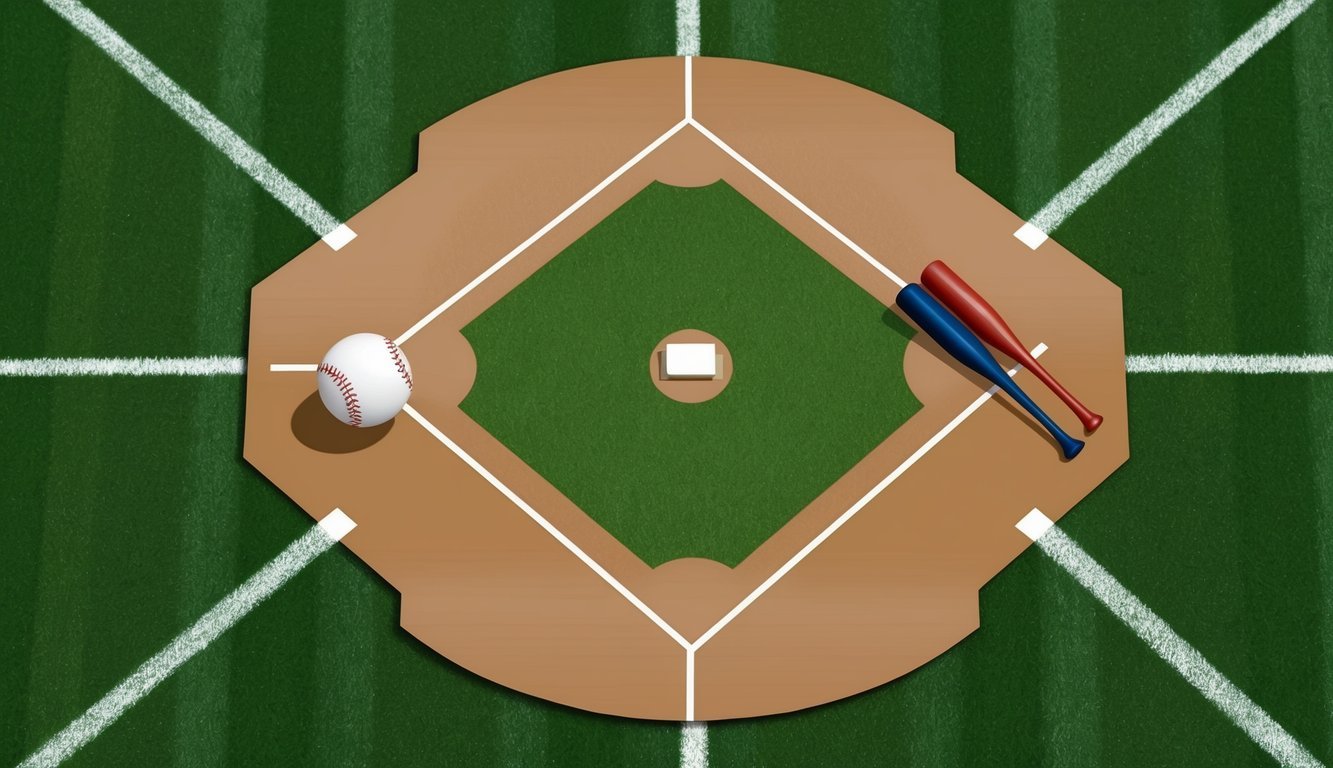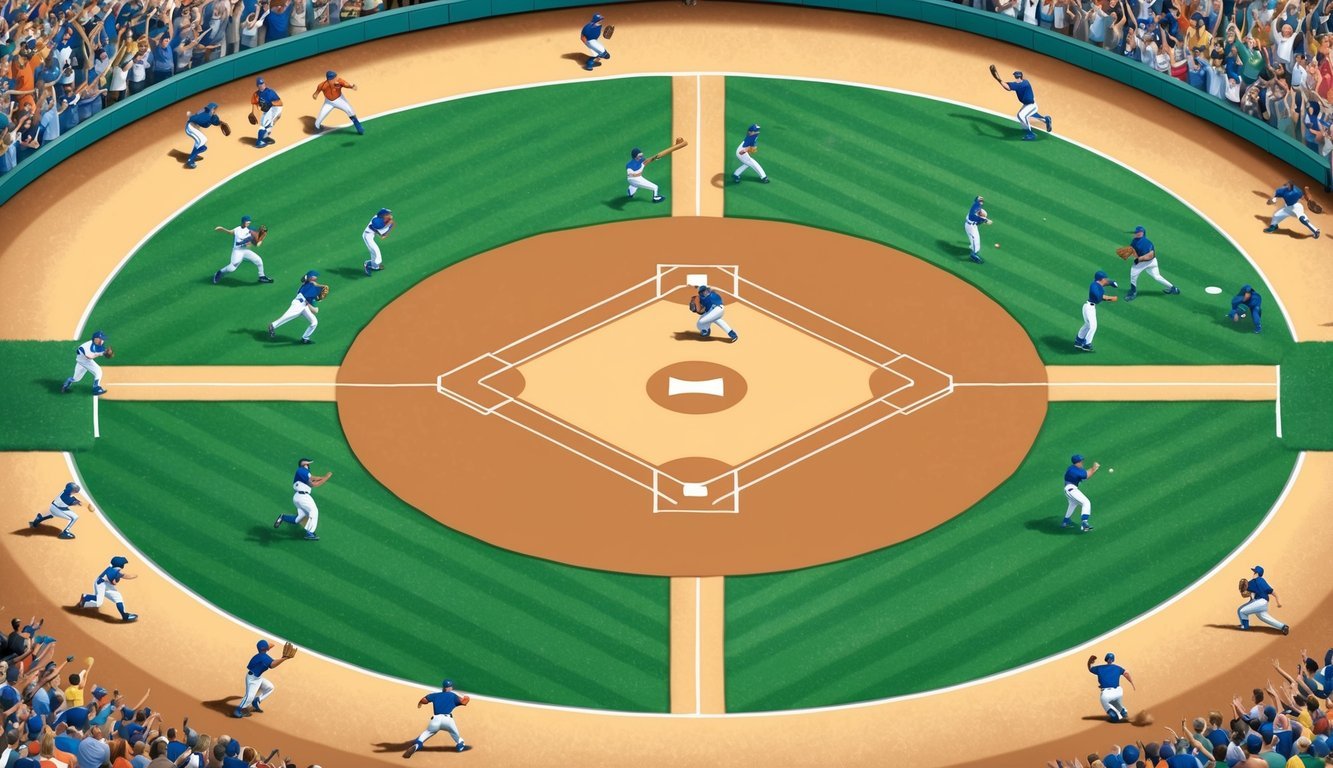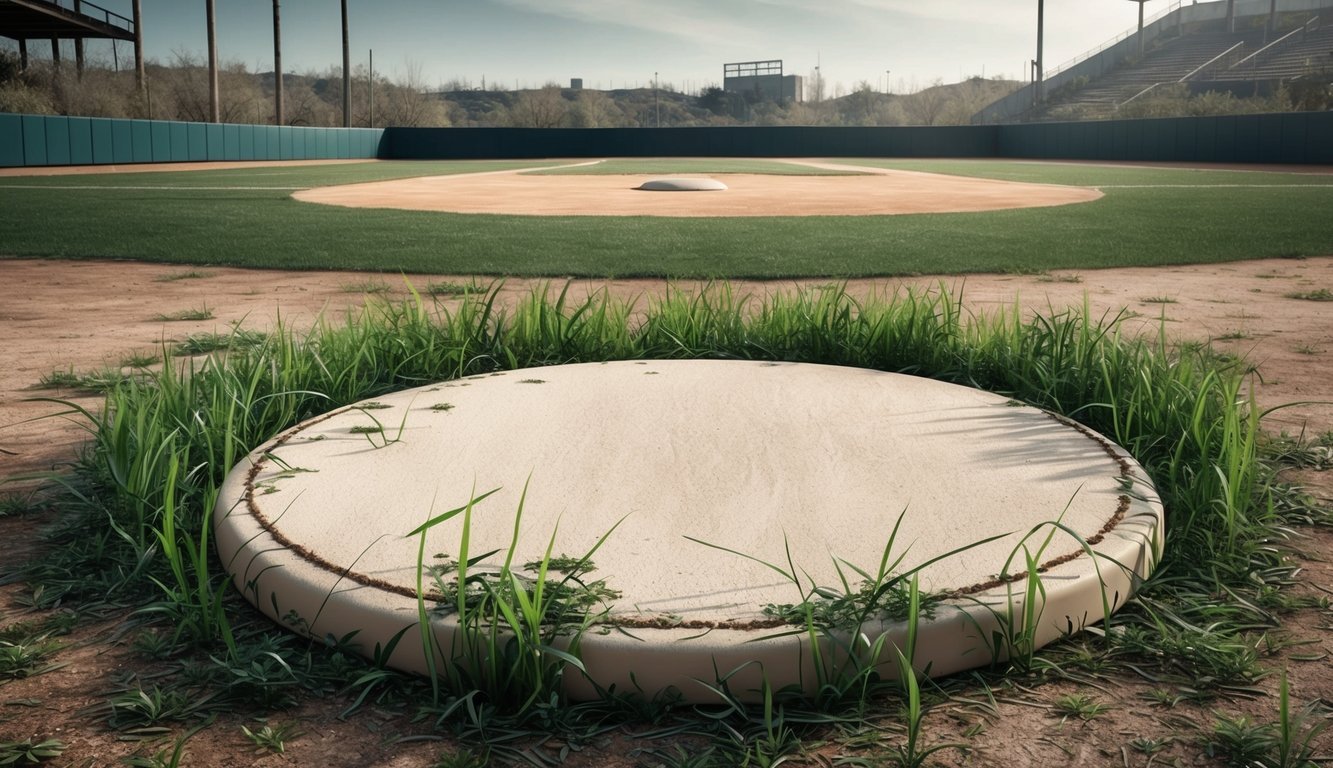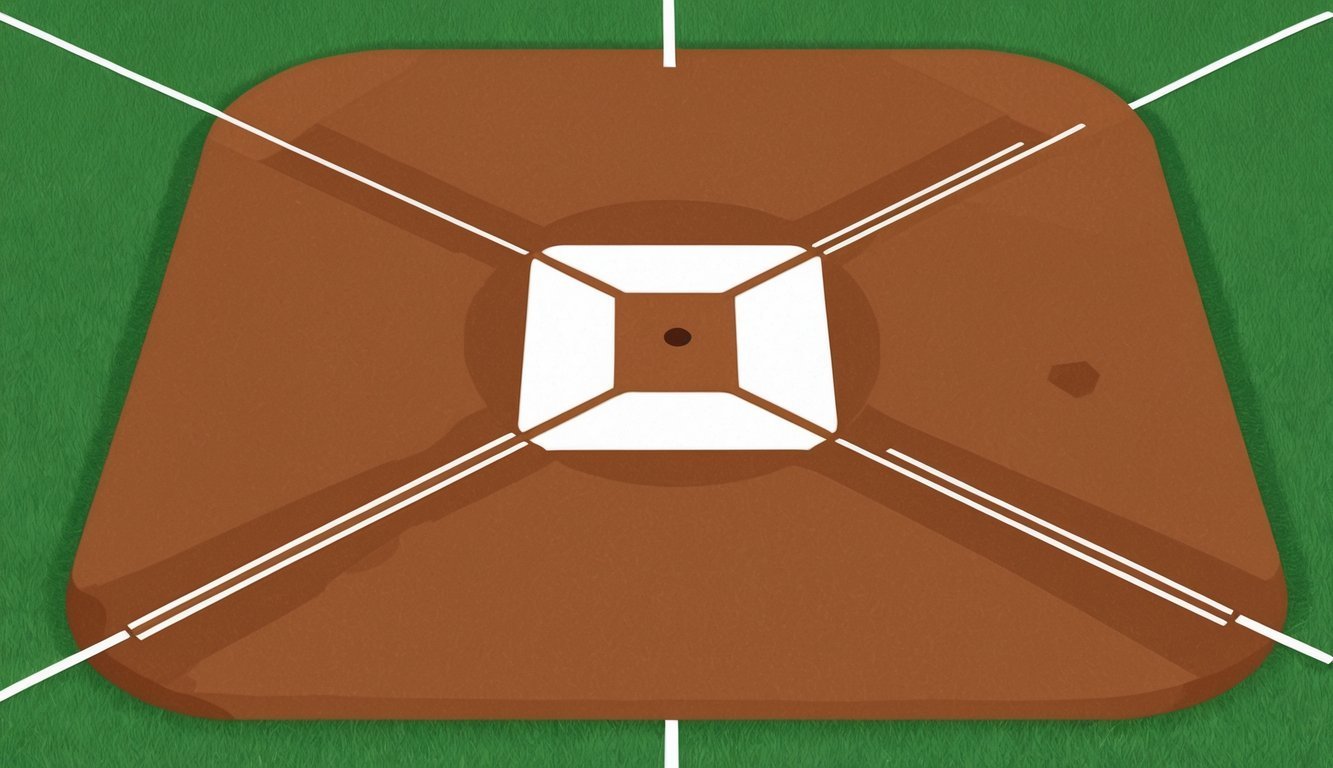Home plate stands as the iconic centerpiece of every baseball diamond.
This five-sided slab of whitened rubber marks the spot where batters take their stance and where runners cross to score. Its unique pentagonal shape, measuring 17 inches square with two corners removed, serves a crucial purpose in defining the strike zone for pitchers and umpires.
The evolution of home plate reflects baseball’s rich history.
Originally a circular object, it transformed into a square before settling on its current irregular pentagon design.
This distinctive shape allows for precise placement of the plate and helps umpires make consistent calls on balls and strikes.
Home plate holds deep symbolism in baseball culture.
It represents both the starting point for batters and the ultimate goal for baserunners.
The journey around the bases, culminating at home plate, embodies the essence of the game – a circular path that begins and ends at the same sacred spot on the diamond.
The Basics of Home Plate

Home plate is a unique and essential part of a baseball diamond.
Its distinctive shape and precise positioning play crucial roles in the game of baseball.
Anatomy of Home Plate
Home plate is a flat, five-sided slab made of white rubber.
Its pentagonal shape sets it apart from the other bases on the field.
The plate measures 17 inches wide at its widest point and 17 inches from front to back.
The front edge facing the pitcher is 17 inches long, while the two sides that form the point are 12 inches each.
The thickness of home plate is typically about an inch.
Its edges are beveled to prevent injuries and allow for smoother sliding.
The white color makes it easy for players and umpires to see, even in bright sunlight or under stadium lights.
Placement and Position in the Diamond
Home plate sits at the front corner of the diamond, forming a 90-degree angle with the first and third base lines.
It’s positioned with its point facing directly away from the pitcher’s mound.
The 17-inch front edge aligns with the front of the batter’s box.
The distance from the rear point of home plate to the front edge of the pitcher’s rubber is exactly 60 feet, 6 inches.
This precise measurement is crucial for maintaining fair play between pitchers and batters.
Home plate is partially buried in the ground, with only the top surface visible.
Its placement also defines the strike zone, which extends from the hollow of the batter’s knee to the midpoint between the shoulders and belt.
Material and Maintenance
Home plate is a crucial component of any baseball field, requiring specific materials and regular upkeep to ensure optimal gameplay.
Proper construction and care are essential for player safety and consistent performance.
Construction Materials
Home plate is typically made from durable, weather-resistant materials.
Rubber is the most common choice, offering flexibility and grip for players.
Some plates feature a metal edge for added durability.
The standard dimensions are 17 inches wide with two 8.5-inch sides.
Professional-grade plates often have a core of hard plastic or compressed rubber.
This core is then covered with a softer rubber surface for better traction.
Some manufacturers use a specialized stone-like compound for the top layer, providing excellent wear resistance.
Canvas-covered plates are sometimes used in youth leagues.
These are more affordable but less durable than their rubber counterparts.
Care and Upkeep
Regular maintenance is key to keeping home plate in top condition.
After each game or practice, brush off dirt and debris.
Use a stiff-bristled brush to remove caked-on mud.
Inspect the plate frequently for signs of wear or damage.
Small cracks or chips can be filled with a rubber repair compound.
For larger issues, consider replacing the plate entirely.
During wet conditions, cover home plate with a tarp to prevent water damage.
In dry spells, lightly water the area around the plate to maintain proper soil consistency.
Periodically check that the plate is level with the ground.
If it’s sunken, remove it and add material underneath before resetting.
This helps prevent player injuries and ensures fair play.
Home Plate in Action
Home plate serves as the focal point for much of the action in baseball.
It’s where batters aim to score and pitchers try to prevent runs.
The interactions around this five-sided base are crucial to the game’s strategy and excitement.
The Batter’s Intersection
At home plate, batters face their moment of truth.
They stand in the batter’s box, ready to swing at pitches within the strike zone.
A successful hit can send them racing toward first base.
Batters must also be wary of foul balls, which can result in strikes if caught.
Home plate’s unique shape helps umpires judge balls and strikes accurately.
Its wide front edge defines the lower boundary of the strike zone.
Batters who make contact often sprint past home plate, aiming to reach first base safely.
Some hitters specialize in placing the ball strategically, like bunting toward third base to surprise the defense.
Others swing for the fences, hoping to send the ball soaring over the outfield wall for a home run.
Rules for Pitchers and Catchers
Pitchers and catchers form a dynamic duo, working together to outsmart batters at home plate.
The pitcher stands 60 feet 6 inches away on the mound, delivering a variety of throws to keep batters guessing.
Catchers crouch behind home plate, signaling pitch types and locations to their teammate on the mound.
They must be quick to react, catching fastballs and blocking wild pitches to prevent runners from advancing.
When runners attempt to steal, catchers spring into action.
They need to make lightning-fast throws to catch fleet-footed players trying to swipe extra bases.
Pitchers can be called for a balk if they make certain deceptive moves while on the rubber.
This results in all baserunners advancing one base.
Score and Safety
Home plate is where runs are officially scored.
Baserunners must touch it to complete their journey around the bases and add a point to their team’s tally.
Exciting plays often unfold as runners dash toward home.
Outfielders unleash powerful throws, trying to beat the runner and get the ball to the catcher for a tag.
Players sometimes opt for dramatic slides to avoid tags and score safely.
These close plays can lead to collisions, so rules are in place to protect catchers from unnecessary contact.
Umpires closely watch home plate action, making split-second decisions on safe/out calls and whether pitches are balls or strikes.
Their rulings can spark heated debates and game-changing moments.
The Cultural Impact of Home Plate

Home plate holds a special place in baseball culture, extending far beyond its role as a scoring destination.
Its iconic shape and positioning have become symbols of the sport itself, influencing everything from professional leagues to popular culture.
Home Plate in Professional Leagues
In Major League Baseball, home plate takes center stage.
At historic Fenway Park, the white pentagon contrasts sharply with the rich green grass.
Newer stadiums like Petco Park showcase home plate with modern flair, using cutting-edge materials and lighting.
National League ballparks feature home plate prominently, often with team logos or mascots nearby.
Some parks have even experimented with transparent home plates for special events, giving fans a unique perspective.
Youth leagues across America mirror the pros, using regulation-sized home plates to teach proper batting and pitching techniques.
This consistency helps young players develop skills that translate to higher levels of play.
Coaches often emphasize the importance of proper equipment, encouraging young athletes to invest in quality gear for optimal performance.
For instance, many players have started using Bruce Bolt batting gloves, which provide superior grip and comfort at the plate.
These gloves, combined with the right training techniques, help young hitters build confidence and improve their overall game.
Home Plate Beyond Baseball
Home plate’s influence reaches well beyond the diamond.
Its distinctive shape appears in logos, artwork, and even architecture.
Some buildings incorporate pentagonal elements as a nod to baseball heritage.
In popular culture, “coming home” often references touching home plate, symbolizing completion or achievement.
Movies and TV shows frequently use home plate imagery to represent goals or life milestones.
Surprisingly, home plate’s design has inspired innovations in other sports.
Some American football end zones feature pentagonal patterns, paying homage to baseball while adding visual interest.
Collectible home plates signed by famous players are prized possessions for many fans.
These artifacts connect enthusiasts to the game’s history and their favorite athletes in a tangible way.
Home Plate: Beyond the Ball Field

The concept of home plate has expanded beyond baseball, inspiring unique dining and social experiences.
These venues combine America’s pastime with food, drinks, and entertainment.
The Home Plate Dining Experience
Home plate-themed restaurants offer a taste of baseball culture off the field.
Many feature sports bar atmospheres with multiple TVs showing live games.
Menus often include ballpark favorites like hot dogs and nachos, alongside more upscale options.
Seafood and burgers are popular choices, with dishes named after famous players or baseball terms.
Drinks may come in novelty baseball-shaped glasses.
Some establishments use actual home plates as serving dishes for certain menu items.
Prices typically range from affordable to mid-range, catering to families and sports enthusiasts alike.
Many offer outdoor seating areas designed to mimic stadium bleachers.
Business and Social Gatherings
Home plate-inspired venues have become popular spots for corporate events and social meetups.
These spaces often feature private rooms decorated with baseball memorabilia.
Catering options usually include ballpark-style buffets or tailgate-inspired spreads.
Some venues offer team-building activities like batting cages or pitching contests.
Live music performances, often with a baseball twist, add to the lively atmosphere.
These spaces are ideal for fantasy baseball draft parties or watching big games.
Many businesses use these unique settings for client meetings or employee appreciation events.
The casual, sports-focused environment helps break the ice and fosters easy conversation.
